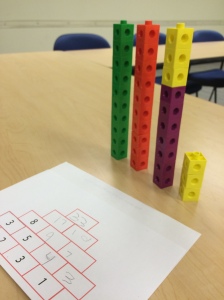Sometimes I have to go to work on days when I don’t have coverage for L – so she gets to come to meetings with me! What a lucky little duck huh?
Last week, I was going to an open writing support time for my college. I suspected that perhaps I would be the only one in the room at the time, but I wanted to be sure that if that wasn’t the case, I could have some things prepared for L that she could complete independently. I brought along some play-doh, some books she hasn’t seen in awhile, coloring, and I printed off a few Halloween-based pages for her. One of them was a math pyramid, which led to my realization that her math knowledge is really growing quickly!
A few months ago, we used a free trial of the Dreambox math app. While we loved the interface, she was frustrated by the concept she was working on, which was to build numbers through subtraction. In other words, to build 57, the app wanted her to move all 100 beads over, then subtract 4 tens, then subtract 3 ones. She wasn’t quite ready to think of numbers this way and we couldn’t get around that topic, so we didn’t extend our free trial.
Since that time, we’ve worked with single-digit subtraction, but have not talked about number building through subtraction. We have done lots of number building through the hundreds with number cards, base ten blocks, and base ten stamps.
In any case, we were using the fourth page of this pdf. I thought she could independently complete the first few rows. I packed up four tens of snap cubes and brought them along.
As I expected, she completed the first few rows independently. She’s got a good memory for addition facts and many of these were within her memory. She added 8 + 9 and 9 + 7 through counting on and correctly figured 17 and 16 as the answers. When it came to adding 17 and 16, though, she paused.
I had pulled out the snap cubes when she began her work and she eyed them at this point. She said, “I think I need to use my cubes.” I said ok, handed them to her, and sat back.
As I mentioned, the cubes were in lines of 10. She took two tens and put them in front of her. She stared at them for a minute and then said, “Three!”. She snapped three off of one of the tens and then placed the ten and the seven next to the number 17 on her paper. She then repeated the process with the other two tens, saying, “Four!” and making 16. Wow! I didn’t expect at all that she would work backwards from the number 20!!
She then took the ten from 17 and the ten from 16 and put them together. She held the 7 and the 6 and looked at them. “This makes more than a ten.” As I watched, she snapped three off of the 6 and added them onto the 7. She then moved the new ten over to the first two tens. I then heard, “Ten, twenty, thirty, thirty-one, thirty-two, thirty-three! It is 33!”
Yes, baby girl, it sure is.

